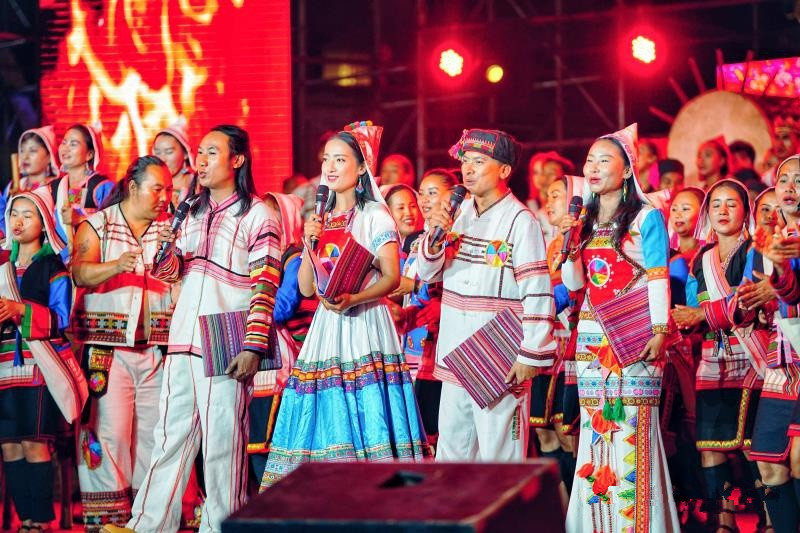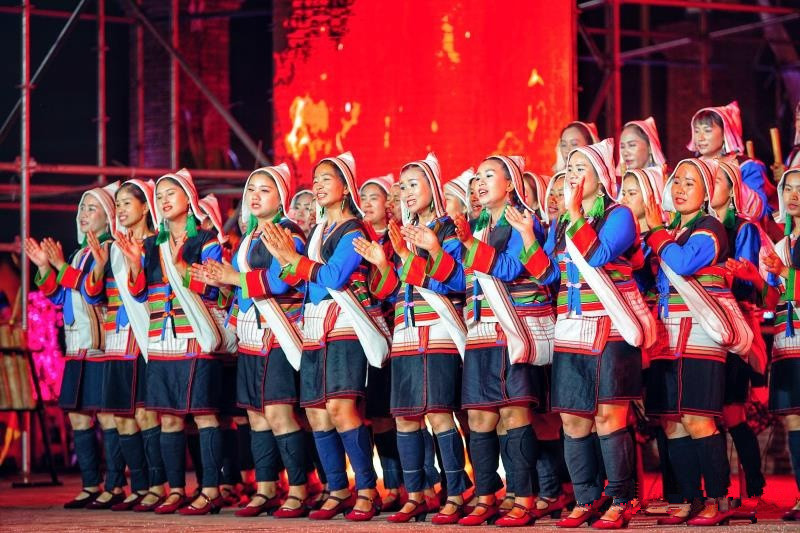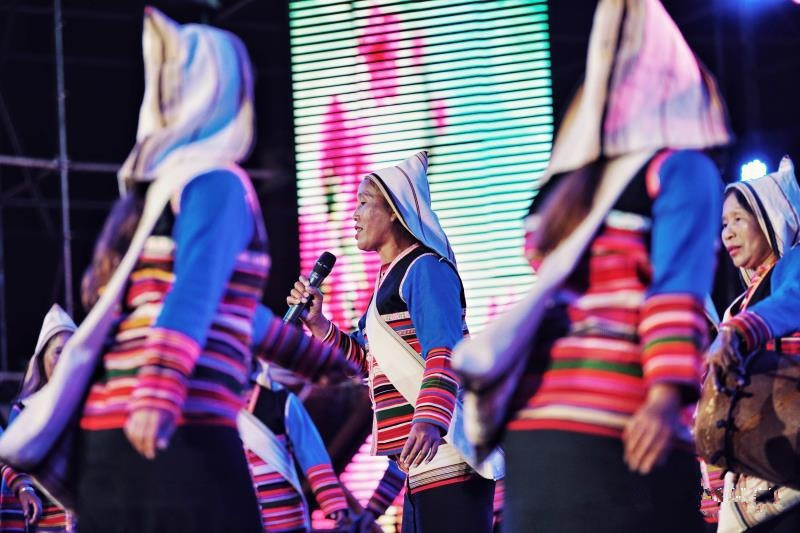
Temaoke Festival of Jinuo Ethnic Minority in Jinghong, Xishuangbanna
Chinese Name:基诺族特懋克节(特毛切节)
English Name: Temaoke Festival of Jinuo Ethnic Minority in Jinghong, Xishuangbanna
The Te Mao Ke Festival is the most grand and significant festival of the Jino ethnic group. This festival does not have a fixed date and is generally celebrated in the twelfth lunar month. “Te Mao Ke” is a phrase in the Jino language, which literally means “to forge iron.” In earlier times, the Te Mao Ke Festival celebrated ironworking, honoring the creation and use of iron tools by the Jino people. Each year during the twelfth month, various Jino villages choose an auspicious date to ceremonially slaughter cattle and pigs to celebrate the occasion.


According to folk legend, when the Jino people were not yet using iron tools, there was a woman who was pregnant for an unusually long time without giving birth. After carrying the fetus for nine years and nine months, she finally delivered. As soon as the baby left the mother’s body, he transformed into a strong man, holding a hammer in his right hand and a pair of tongs in his left, preparing to forge iron in a workshop. From then on, the Jino people began to use iron knives, iron axes, and other iron tools. To commemorate this historic change, the Jino people celebrate the forging festival known as Te Mao Ke each year during the twelfth lunar month, allowing this festival to be passed down from ancient times to the present.
Although the Te Mao Ke Festival is a festival for the entire Jino community, the activities used to be organized at the village level, with the timing of the celebrations decided by the elders known as “Zhuoba.” However, the procedures and content of the festivities were generally similar across villages. Most villages would pool money to buy a cow, conduct a bull-catching activity, and offer bamboo rats to blacksmiths, culminating in collective activities such as dancing the grand drum dance at the home of the Zhuoba. In villages that did not hold the bull-catching activity, there would often be a cow slaughtered at the Zhuoba’s house and a pig slaughtered at the Dazhai’s house, followed by a communal feast and dancing.
In earlier celebrations of the Te Mao Ke Festival, all activities were arranged by the Zhuoba. On the morning of the festival, with great excitement, the Zhuoba would strike a large drum kept in his house, signaling the start of the celebrations. Upon hearing the “boom” of the drum, people would hurriedly change into festive attire and rush to the designated bull-catching grounds. Once the villagers gathered, the Zhuoba would approach the yellow cow that was to be killed with a spear and recite traditional bull-catching verses, directing people in the activity. A group of men holding bamboo spears would take turns throwing their spears at the tightly bound yellow cow until a spear pierced its body and blood flowed out. Only then would they retrieve their spears to slaughter the cow, skin it, and distribute the meat.
When dividing the meat, the first step is to cut seven portions for the seven elders in the village, known as the “Seven Old Ones,” which include Zhuoba, Banuo, Zhuose, Senuo, Kebu, Buno, and Nainu. The remaining meat would then be evenly distributed among the households based on the amount each household contributed. On this day, each household would also prepare a chicken or collaborate to slaughter a pig, arranging a lavish feast. At noon, the male heads of households would bring their prepared wine, meat, and dishes to the Zhuoba’s house to participate in the worship of the grand drum. On the altar in front of the drum would be placed the hammer and tongs used by the blacksmith, along with items such as chicken feathers, ginger, taro, cockscomb flowers, and golden daisies. The Zhuoba, along with the seven elders, would take their seats in turn, while the Zhuoba recited the sacrificial words, striking the drum and leading the people in the grand drum dance, singing songs to bid farewell to the old year and welcome the new one.
In the evening, the “Seven Old Ones” would visit each household in the village to offer their congratulations, having dinner together with each family. That night, all the men and women of the village would gather at the Zhuoba’s house to listen to singers perform farewell songs for the old year and welcoming songs for the new year. Young men and women would sing and dance near the Zhuoba’s bamboo house, enjoying themselves until dawn.
On the following day, villagers would send a bamboo rat to the blacksmith and accompany him and his apprentice to the home of Zhuose for a symbolic iron forging activity. The blacksmith and his apprentice would heat a piece of iron and hammer it, symbolizing the good forging of new knives and axes, preparing for the spring plowing. After this, people would engage in various cultural activities such as swinging, spinning tops, tossing bags, and walking on stilts or visiting friends in nearby villages, enjoying the festive celebrations.

 7 Days GolfingTour
7 Days GolfingTour
 8 Days Group Tour
8 Days Group Tour
 8 Days Yunnan Tour
8 Days Yunnan Tour
 7 Days Shangri La Hiking
7 Days Shangri La Hiking
 11 Days Yunnan Tour
11 Days Yunnan Tour
 6 Days Yuanyang Terraces
6 Days Yuanyang Terraces
 11 Days Yunnan Tour
11 Days Yunnan Tour
 8 Days South Yunnan
8 Days South Yunnan
 7 Days Tea Tour
7 Days Tea Tour
 8 Days Muslim Tour
8 Days Muslim Tour
 12 Days Self-Driving
12 Days Self-Driving
 4 Days Haba Climbing
4 Days Haba Climbing
 Tiger Leaping Gorge
Tiger Leaping Gorge
 Stone Forest
Stone Forest
 Yunnan-Tibet
Yunnan-Tibet
 Hani Rice Terraces
Hani Rice Terraces
 Kunming
Kunming
 Lijiang
Lijiang
 Shangri-la
Shangri-la
 Dali
Dali
 XishuangBanna
XishuangBanna
 Honghe
Honghe
 Kunming
Kunming
 Lijiang
Lijiang
 Shangri-la
Shangri-la
 Yuanyang Rice Terraces
Yuanyang Rice Terraces
 Nujiang
Nujiang
 XishuangBanna
XishuangBanna
 Spring City Golf
Spring City Golf
 Snow Mountain Golf
Snow Mountain Golf
 Stone Mountain Golf
Stone Mountain Golf















